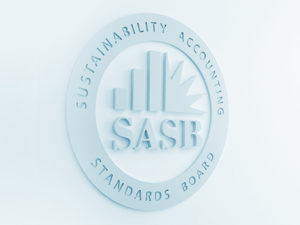
Ekaterina Hardin Analyst, Sector Lead – Extractives & Minerals Processing
The Sustainability Accounting Standards Board (SASB) is currently engaged in stakeholder consultation for its standard-setting project on tailings management in the Extractives sector. Given an overwhelming amount of interest in this project, we wish to share the expected timeline and some major milestones of the project and provide an opportunity for experts on the subject to provide input for preliminary analysis.
Since the SASB standards were codified in November 2018, there has been a significant evolution of investor interest and corporate disclosure related to tailings facilities management. These developments are due in large part to high-profile events, such as the catastrophic dam collapse in Brumadinho, Brazil in January of 2019 that killed nearly 300. SASB is currently re-evaluating its relevant standards to ensure they fulfil their intent to provide decision-useful information to investors in industries covering mining operations. Management of tailings facilities has been included in the SASB standards for the Metals & Mining and Coal Operations industries since SASB developed its first, provisional exposure draft for these industries in 2014. However, as global investors continue to express interest in the topic and evaluate the utility of various existing and proposed reporting frameworks, we believe there is opportunity to improve the industry standards in this area. The current standards for the Metals & Mining and Coal Operations industries within the Extractives & Minerals Processing Sector are being evaluated for potential revision to ensure the set of disclosures fully captures the risks associated with company management of tailings storage facilities (TSF). The project also aims to improve global applicability of the standards.
Background
Tailings are mining operations waste, usually stored in ponds or dams, frequently covering very large land areas. Impoundments for tailings can present a significant threat if they collapse, potentially leading to the loss of life and/or damage to property and ecosystems, which bears significant financial implications. Recent catastrophic failures of TSFs include Imperial Metal’s 2014 release of waste slurry in Canada’s Polley Lake, a 2015 dam failure in Mariana, Brazil (a Vale/BHP joint venture), which entailed $6 billion in expenditures to restore the environment and affected communities, and Vale’s tragic January 2019 dam collapse in Brumadinho, which resulted in a $4.95 billion loss for the company in the first quarter after the disaster.
Following the Brumadinho catastrophe, the Investor Mining & Tailings Safety Initiative (currently representing more than $13 trillion in assets under management) wrote to 726 extractive companies seeking enhanced disclosure on the management of TSF. The initiative gave companies—including major names in the mining industry such as BHP, Rio Tinto, Anglo American, Glencore, and Vale—45 days to publicly disclose their dams’ size, construction methods, and safety records. The letter posed 20 questions to companies on issues such as the height and type of dams, capacity, engineering records, and safety checks. The engagement was aimed at providing institutional investors with information for assessing the risk associated with holdings in mining companies.
The Investor Mining and Tailings Safety Initiative has stated that in response to their engagements, as of Feb. 26, 2020, 40 of the top 50 mining companies have made public disclosures related to TSF management, which has resulted in information about thousands of individual tailings dams/facilities being made public on company websites. Over 83 percent of the mining industry by market capitalization has responded, and all 23 publicly owned companies that are members of the International Council on Mining & Metals (ICMM) responded and disclosed information about their tailings dams/facilities. In January of 2020, the Investor Initiative held a summit, where they summarized the work conducted in the year since the Brumadinho disaster, where among other things, the Initiative recognised a need to explore improved ways of reporting on tailings.
In response, in June of 2019 the International Council on Mining and Metals (ICMM), which is made up of 26 of the world’s leading mining and metals companies and 35 associations, began working with the United Nations Environment Programme (UNEP) and the Principles for Responsible Investment (PRI) on development and adoption of global best practices on TSF management. They have co-convened The Global Tailings Review (GTR) to establish an international standard that aims to prevent catastrophic failures by creating a step change for the industry in the safety and security of TSF management practices. The first draft of the Global Tailings Standard was published on Nov. 16, 2019, and the GTR is currently incorporating public comments in the next revision, which is set to be finalized by the end of Q1 2020.
SASB’s Standard-Setting Project
This significant evolution in investor interest, resulting changes in corporate disclosure, and establishment of a global initiative that among other things aims to standardize disclosure around tailings facility management, all support the need for SASB to re-evaluate its existing topic and metrics to ensure they capture current market thinking and convey the most useful information on this issue.
As part of its standard-setting project, SASB has been conducting extensive stakeholder consultation. This consultation period is planned to conclude in March. As part of this phase, SASB has consulted with major mining companies and industry professionals. Additionally, we are closely monitoring developments around the Global Tailings Review and the Investor Mining & Tailings Safety Initiative, including responses to the Initiative by the mining sector.
As the consultation phase continues, SASB seeks to engage with individuals involved in asset management and asset ownership, especially in European and Asian markets, who have direct experience with assessing and integrating risks associated with tailings management into their investment decisions. If you would like to provide input on how these risks should be quantified and standardised, understanding that no tailings facility is alike, please contact Ekaterina Hardin, SASB’s sector lead for Extractives and Minerals Processing, at [email protected].
SASB also seeks to collect input from mining companies that own or operate TSFs. If you would like to contribute to this preliminary analysis of best practices around tailings facilities disclosures to investors, please contact us. We are seeking suggestions on a set of representative information that companies can cost-effectively collect and report. The same set of information should also be decision-useful for investors, while not requiring discipline-specific expertise on the subject of tailings impoundments design, construction, and management. We are also interested in market feedback on the nature of tailings management risks within the context of environmental, social or governance dimensions. Finally, we are also interested in recommendations for revisions to the existing metrics or alternative metrics that could be helpful to investors in assessing an entity’s performance on this qualitative issue.
SASB seeks to understand how it can ensure its standards fully capture the risks associated with tailings storage facilities, and to how SASB can align, where possible, with ongoing initiatives such as the GTR and Investor Mining & Tailings Safety Initiative, thereby providing decision-useful information to all investors.
Looking Ahead
At the conclusion of this consultation period, SASB intends to publish a summary of comments received from stakeholders, without attribution to individuals or their affiliated organisations. This update is tentatively set to be made available to the public in May 2020, ahead of the Q2 Standards Board meeting (June 22-23). SASB will provide an update at this time regarding next steps, which may include the development of an exposure draft with proposed changes to the standard and an associated public comment period.
SASB intends to publish interim project updates as appropriate and welcomes public input at any time.
Ekaterina Hardin is the Extractives & Minerals Processing Sector lead for SASB. She may be reached at [email protected].


